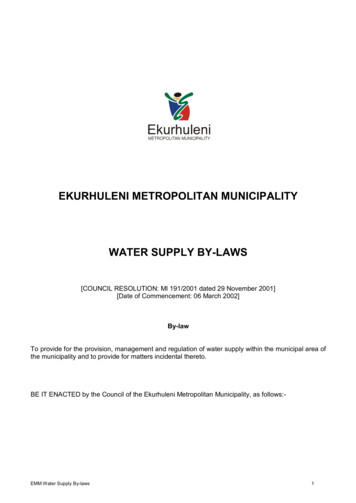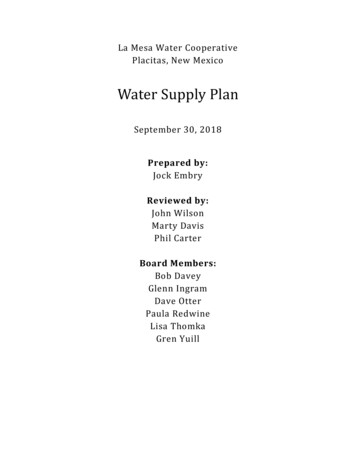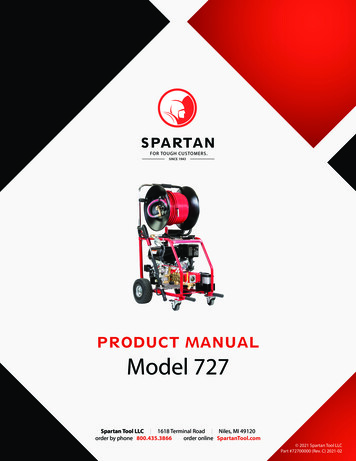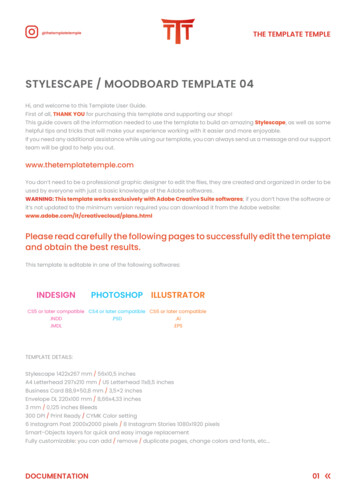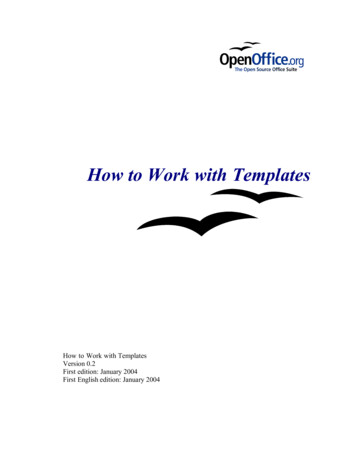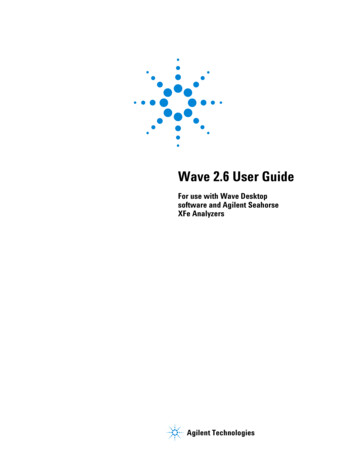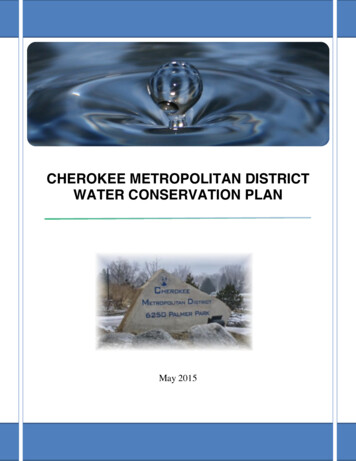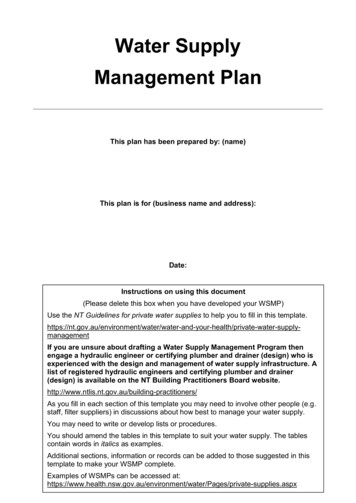
Transcription
Water SupplyManagement PlanThis plan has been prepared by: (name)This plan is for (business name and address):Date:Instructions on using this document(Please delete this box when you have developed your WSMP)Use the NT Guidelines for private water supplies to help you to fill in this -and-your-health/private-water-supplymanagementIf you are unsure about drafting a Water Supply Management Program thenengage a hydraulic engineer or certifying plumber and drainer (design) who isexperienced with the design and management of water supply infrastructure. Alist of registered hydraulic engineers and certifying plumber and drainer(design) is available on the NT Building Practitioners Board tioners/As you fill in each section of this template you may need to involve other people (e.g.staff, filter suppliers) in discussions about how best to manage your water supply.You may need to write or develop lists or procedures.You should amend the tables in this template to suit your water supply. The tablescontain words in italics as examples.Additional sections, information or records can be added to those suggested in thistemplate to make your WSMP complete.Examples of WSMPs can be accessed /Pages/private-supplies.aspx1
BackgroundThis template will help private water suppliers develop a water supply management plan(WSMP), and can be altered to ensure it is relevant to each water supply system.A WSMP must address the Framework for Management of Drinking Water Quality set outin the Australian Drinking Water Guidelines (ADWG 2011), in a way that is appropriate toeach water supply. The Australian Drinking Water Guidelines are available eh52The NT Guidelines for private water supplies will also help private water suppliers developa WSMP and are available ur-health/private-water-supplymanagementFurther information can be found by contacting the Department of Health – EnvironmentalHealth (DoH):Department of Health – Environmental HealthPolicyTop End Health ServiceCentral Australia Health ServicePh. (08) 8922 7152(08) 8922 7377(08) 8955 6122envirohealth@nt.gov.auenvirohealthte@nt.gov.au envirohealthca@nt.gov.auWater supply management planA water supply system includes everything from the collection of the source water throughto the point of use. When developing a WSMP for a water supply system an operator shouldask three questions: What problems could occur between the water source and the point of use?How can they be prevented or fixed?How do you know that the problem has been prevented or fixed?The answers to these questions will help determine how to: assess and protect the quality of the source watermake sure treatment processes are appropriate, maintained and working properlyregularly test the water qualitymake the water supply safe if contamination has occurredmake sure that water users are warned and/or provided with safe drinking water ifthe normal supply is found to be unsatisfactory or the quality cannot be guaranteed.Keeping the water supply system safe involves: identifying who is responsible for the system and who will respond to issuesunderstanding hazards to your water sourcesmaking sure the water is stored and distributed safelytreating the water to remove or control any contaminationmonitoring the quality of the water and the integrity of the water supply systemplanning on how to respond to problems in the water supply system.Your WSMP should reflect the type of water supply system you manage, especially thewater source and its end uses. While DoH recommends that water supplies be monitoredregularly, operators may choose not to monitor water quality. If the water supply is not2
monitored or treated, and is not required to be of drinking water quality (water used in foodpreparation must be drinking water quality), operators may choose to manage their risk byplacing signs at outlets to warn consumers. See the NT Guidelines for private water suppliesfor information on signage. A WSMP must still be developed and should include details onall signage. If you use your water supply to prepare food, please visit the NTG webpage Private water supplies in food private-water-supplies-in-food-businessesWhat to do with the WSMPYou should provide a copy of the completed WSMP to DoH for review.The WSMP should be a living document that is reviewed regularly. Any changes that occurto the water supply system or any new hazards that are identified from observations,equipment checks, incidents or monitoring should be added to the relevant section of theprogram.Your WSMP should be kept in a central place that is easily accessible to staff and otherswho may need to view it, such as officers of DoH.3
The activities in this WSMP are undertaken by thisbusiness/development to ensure safe drinking water and to protectpublic health.1. Basic information1.1 Private water supplier’s detailsProperty/business nameOwner/occupier nameOwner /occupier contactdetailsPhoneMobile PhoneEmailAddressBusiness after-hours /emergency contactNamePhoneMobile PhoneEmailAddress1.2 Water supply system monitoring and maintenance personnel details (if differentfrom above)Roles and responsibilitiesName and phonenumber of mainperson responsibleName and phonenumber of any otherpeople responsible4
1.3 Description of the water supply systemDescribe the details of your water system from source to use. (Delete any that are notrelevant)Tick ComponentDescriptionWater sourcesGroundwater (bore)DamRiver / creekRainwater (roof water)Carted waterTreatmentFiltrationUV disinfectionChlorinationFirst flush diverter(rainwater tanks)OtherDistributionStorage/header tankPipesPumpsOtherUsesDrinkingFood preparation(including washing ofproduce and cleaningof utensils andequipment)Personal hygiene(showers, toilets etc.)Clothes washingOther5
2. Diagram of the water supply systemDraw a simple diagram of your water supply system. Show the water source, pumps,storage, treatment, pipelines and uses. Include the location of wastewater systems (forexample, septic tanks), any possible sources of contamination and the location of physicalcontrol measures such as fences, signs, etc. The diagram must reflect the details of thewater supply system but does not need to be to scale. An example diagram is included inAppendix A.6
3. Risk assessment of the water supply systemUnderstanding the risks to your water supply is a crucial step in ensuring its safety. Actionsshould be prioritised on the basis of level of risk.The hazards to the water supply are considered and rated following the advice in the WSMPtemplate and the NT Guidelines for private water supplies. Note all controls which are inplace to address the hazards, and actions required to improve the ongoing protection of thewater quality. Use the following risk assessment process.Document your risk assessment in the next template table, using the following steps. Createas many pages as required. It is important to review your risk assessment regularly to ensureany new risks are identified.Step 1: Identify particular hazards in the water supply in the risk assessment template. Thetable in Appendix B gives examples of some hazards and is provided to assist in completingthe “Hazard” column of the Risk Assessment.Step 2: Assign risk rankings. Once all possible hazards are listed, assign a risk ranking toeach hazard as low, medium or high in the risk assessment template. Consider the likelihoodof the hazard occurring and, if it does, the severity of the consequence. The table inAppendix C may assist in ranking risks.Step 3: Identify controls. Decide whether the hazards identified in the system have controlsin place and describe these controls in the risk assessment template. Controls are the waysthat risks will be managed, for example excluding animals from dams used for humandrinking water, regular inspection and maintenance programs or water treatment. The tablein Appendix B gives some more examples of possible controls for various hazards.Step 4: Monitoring of controls is important to ensure they are working effectively. Describein the risk assessment template how, when and where monitoring will occur, who isresponsible, how and where records will be kept and by whom. Consult the NT Guidelinesfor private water supplies for information on monitoring.Step 5: Where hazards are identified, consider what could be done to improve safety andreduce the risk of those hazards. List any shortcomings in your water supply system and itsmanagement and identify what improvements should be made. Document theseimprovements in your risk assessment template.Step 6: Prioritise actions that need to be taken to protect the water supply and give them apriority number or time frame in the risk assessment template.7
Risk assessment templateStep 1Step 2HazardRiskRankStep 3Is theHazardControlled?If Yeswhat isthecontrol?Step 4Step 5Step 6How isthiscontrolmonitored?What couldbe done toimprovesafety?Timeframefor actione.g. Surface waterdam – access byfarm animals(potential formicrobiologicalcontamination)HighNoFencing ofdame.g. River waterdirty looking afterheavy rain(probable bacterialcontamination)HighYesAfter 90mm ofrain, pumpis switchedoff andwatercartercalled totop upmain tankRain gaugemonitoredhourly duringrainfall.Visual checkof river watercoloure.g.Rodents/animalsaccessing roof(probably bacterialcontaminationMediumPartlyTreestrimmed sonotoverhanging roofVisualinspection oftreesannuallye.g. Taste anddiscoloration ofwater from leavesentering storagetankLowYesOverhanging ionsystemShut off assoon as rainbegins.12 months6 monthsCurrentlymanagedCurrentlymanaged8
4. Management actions and record keepingAn inspection and maintenance program and a water monitoring program are needed andare described in this section.In the following tables records will be kept for: all inspections, maintenance, carted water or incidents/emergencies. Theserecords include system inspectionsall results of microbial and chemical testing, and chlorine levels (whereapplicable)maintenance to the water system such as tank cleaning, filter change,chlorinationincidents and corrective actions e.g. dead animal in tank, storms, treatmentbreakdowndeliveries of carted water, including date and name of supplierthe placement and checking of warning signs.4.1 Planned water supply system inspection and maintenance programAn inspection regime should address all aspects of the water supply system. Examples ofinspections are included in Appendix D.Regular inspection and maintenance is essential to maintaining a well functioning and safewater supply.What is to beHow often it is to beinspected/maintained inspected/maintained(frequency or dates)Who should conductAny equipmenttheor proceduresinspection/maintenance neededCheck catchment-roofand guttersmonthlyManagerLadderTop up fuel for pumpweeklyManagerFuel tank, funnel,gloves,pumpcompound keyPower supply operatingdailyManagerKey to plantroomUV lamp6 monthlyService company technicianSupplied bytechnicianUV treatment9
4.2 Water supply system inspection and maintenance recordsMake a record every time a supply system item is inspected or maintained.DateWhat wasinspectedNotesActions to be takenPersonResponsible3.3.13Roof & guttersGutter loose near NE cnr ofhouseDown pipe at SW cnr beginningto rustReconnected looseJohn Smithgutter during inspectionCheck downpipe nextmonth5.3.13Pump motorTopped up fuel, mowed grassClean air filter at nextvisitJohn Smith4.3 Equipment detailsRecord details of pumps, parts, treatment systems and chemicals. Include details ofmanufacturers, supplier and repairers.The manufacturer’s instructions are attached to the WSMP.Part / EquipmentManufacturerSupplier/RepairerContact DetailsUV equipmentWater pumps10
4.4 Sign postingSigns can be a useful way of communicating with customers. Signs may be permanent ortemporary. Examples of warning signs can be found in the NT Guidelines for private watersupplies.Signs must be checked to ensure they are present and able to be read.Sign locationSign wordingPermanent or InspectionTemporaryDateAny actiontaken4.5 Water quality monitoring programWater quality monitoring is important in ensuring controls are effective and in response toconcerns. Refer to the NT Guidelines for private water supplies for information on developinga monitoring program which is suitable for your system.This table describes the tests that will be made.What is to bemonitoredHow often aretests to be taken(frequency ordates)Onsite testse.g pH, chlorineDaily chlorine levelsLocation oftestsWho shouldperform thetestEquipment neededand procedures forperforming the testAt tank and attap in laundryManagerTest kitProcedures are writtenon the lid of test kit.MicrobiologicalChemical11
4.6 Water quality monitoring resultsMake a record every time water is tested, detailing what was tested, when, results and actions.DateWhere test was takenfromType of testtakenTest resultAny actiontakenPersonresponsible4.7 Records of water purchased from a water carterMake a record every time drinking water is purchased from a water carter and added intothe water supply system.DateName and details of water carterVolume of water purchased12
4.8 Chlorination recordsFor guidance on the safe use of chlorine see Chapter 5 of the NT Guidelines for privatewater suppliesIf chlorine is used, record the details in the table below.DateVolume of watertreated (litres)Amount ofchlorine addedFree chlorine test result(mg/L)Personresponsiblemg/L milligrams per litre, this is the same as ppm (parts per million)4.9 Incident recordsIf incidents, issues or emergencies occur that impact on the water quality, record whathappened and what was done to rectify the situation. Include any customer complaints aboutwater quality.DateIncidentNotes and corrective actionsPersonresponsible12/5/19e.g. Dirty water noticedcoming out of taps afterheavy rainHeavy rains after dry spell washed dirt into rainwatertank and resuspended sludge as tank level was low.Potential for bacterial contamination. Tank has notbeen cleaned recently. Advised customer to boilwater before use and supplied bottled water torooms. Booked tank cleaner and water carter to refilltank. Checked roof and gutters. Checked first flushdiverter.Nicola Smith13
5. Contingency and emergency planningThis is what is planned: if there was a problem with an important part of the water supply systemin response to a failed water quality testto ensure all people responsible for the water supply system have the knowledgeand skills to run the system, e.g. training temporary managersin response to customer complaints regarding water qualityin response to any other issue.5.1 Contingency planIssueLikely actions that could be takene.g. Algal bloom in dam Contact DoH for advice Signpost all outlets that water supply may be contaminated and notto be used for drinking or bathing Review control measures Test water for toxins Provide an alternative supplye.g. detection of E. coli in awater sample Contact DoH for advice Undertake disinfection, e.g. chlorination Signpost all outlets that water supply is contaminated and not to beused for drinking, food preparation or consumed when cleaningteeth, bathing or showering Review control measures Provide an alternative supply Re test water for E. coli14
5.2 Emergency contactsKeep details of who to contact in an emergency, who to call for advice and important localcontractors. Keep these details in an easily accessible place.ContactNameDoHEnvironmental HealthPollution IncidentHotlineNT Environment ProtectionAuthorityContact details1800 064 567PlumberTank cleanerWater carterChlorine supplierElectricianHydraulic consultant15
APPENDIX A: Example water supply system diagramWater supply source 1 – Creek waterWater supply source 2 - RainwaterCreekShedRain tankFirst FlushdiverterPumpFilterCreek storagetank(untreated)UltravioletdisinfectionFirst FlushdiverterPumpPumpAccommodation buildingUses of untreatedcreek water Toilet flushing Laundry Garden outlets Hand basins ShowersWarning signs in bathroomsalerting that water is untreatedUses of treatedrainwater Kitchen taps Drinking watertapsSepticTank downhillOnsite effluent disposal areadownhill of creek16
APPENDIX B: Common sources of contamination (hazards) and suggested controlmeasuresComponentPotential source of contaminationControl measuresWater sourceRain waterRoof and gutters (e.g. build-up ofleaves, dirt and animal droppings) Rain waterRoof material (e.g. lead-based paint,lead flashing, bitumen-containingproducts, treated timber, peeling paint) Water not collected from roofs coated or painted withsubstances that may leach hazardous materials Remove or treat lead flashing Seal any exposed treated timberSurface water (dams, creeks andrivers)Surrounding land use (e.g. farming,urban areas, industrial sites andsewage discharges) Protect surface water source against livestock, septictanks/sewage overflows and chemical spills Water treatmentSurface water (dams, creeks andrivers)Animal and human activities Fence water storage or off-take area Don’t permit swimming or public access in off-take area Water treatmentGroundwater (bore, well, spring)Surface water seepage Raise bore heads above ground level and mound upground around bore head Ensure bore covers and casing are intact Regular inspectionsGroundwater (bore, well, spring)Sub-surface contamination (e.g. fromindustry, farming, landfill, sewage) Extract groundwater from places where sub-surfacecontaminants are unlikely Test the water for chemicals and treat if necessary Groundwater source is at least 20 metres from anywastewater disposal systems Water treatment (disinfection)Insect, birds and animals in system Screen all inlets and outlets to the tank Regular inspections of tank, roof and guttersBuild up of sludge in tank, dirt in inletstrainers or insect screens Regular inspection, cleaning and maintenance programTank materials (e.g. pH of water inconcretetanks, high metals from metallic tanks) Materials in contact with water comply with relevantAustralian Standards (refer to Appendix 1) Chemical adjustment of pH in new concrete tanks may benecessaryBackflow water (e.g. from animal watertroughs) Backflow prevention devicePump and plumbing materials All materials in contact with water comply with AS/NZS4020:2005Leaching from bore casings, pipes orplumbing materials All materials in contact with water comply with AS/NZS4020:2005 Flush standing water at irregularly used fixturesWaterStorageDistributionsystemFirst flush deviceRegular cleaning of roof and guttersRemoval of overhanging branchesRegular inspectionsWater treatment (disinfection)17
APPENDIX C: Identification of riskConsequenceLikelihoodMinorModerateMajorRareLow RiskLow RiskMedium RiskPossibleLow RiskMedium RiskHigh RiskLikelyLow RiskMedium RiskHigh RiskTo identify a risk as low, medium or high, use the above matrix of likelihood andconsequence. As an example: A hazard with rare likelihood but major consequence will beassigned a medium risk. Events that may cause sickness would be assigned a majorconsequence, for example bacterial contamination of a dam or rainwater tank, or an algalbloom in a dam.Likelihood can be assessed as Rare: the hazard may only occur in exceptional circumstances, for example every 2to 5 years Possible: the hazard might occur or should occur at some time, for example 2 to 4times per year Likely: the hazard will probably occur in most circumstances, for example everymonthConsequence can be assessed as Minor: causing a minor impact on a small number of people, some manageableoperation disruption, or some increase in operating costs, for exampleconsequences which can be managed by normal operations Moderate: causing a minor impact on more people, significant modification tonormal operations but manageable, operation costs increased, or increasedmonitoring, for example consequences that may involve additional time andexpense to manage Major: causing a major impact for any number of people, system significantlycompromised, operation abnormal if operating at all, high level of monitoringrequired. Any consequence involving consumers falling ill should be consideredmajor18
APPENDIX D: Possible water supply system inspectionsA range of inspections may need to be conducted on various aspects of the water supplysystem. Possible inspections include:Water source––river, creek, dam and bore water Check upstream for contamination (monthly or after heavy rains) Check upstream during warmer months for blue-green algae blooms (weekly) Check the intake area (monthly) Check the fenced livestock area (monthly) Check well head is secure and free from water (monthly or after heavy rains) Check maintenance and operation of pump (annually)Tank Check inlet and outlet screens (3 monthly)Check access covers (3 monthly)Clear strainer for debris (3 monthly and after heavy rains)Check presence of mosquito larvae in tank water (3 monthly)Check structural condition (annually)Check sludge level and internal cleanliness (every 2 years or as required)Check roof condition and ensure no overhanging trees (3 monthly)Distribution system Check plumbing/piping is fully operational and well-maintained (annually) Check treatment system is operating as per manufacturers advice Replace filters (as per manufacturer’s advice or earlier if a decrease in water flow isnoticed) Test chlorine level is at or above 0.5 mg/L (regularly as per NT Guidelines forprivate water supplies) Check UV light is operating (daily) Check UV light is visually free from scum (as per manufacturer’s advice) Replace UV light source (as per manufacturer’s advice) Other treatment (as per manufacturers advice)19
This template will help private water suppliers develop a water supply management plan (WSMP), and can be altered to ensure it is relevant to each water supply system. A WSMP must address the Framework for Management of Drinking Water Quality set out in the . Australian Drinking Water Guidelines (ADWG 2011), in a way that is appropriate to
